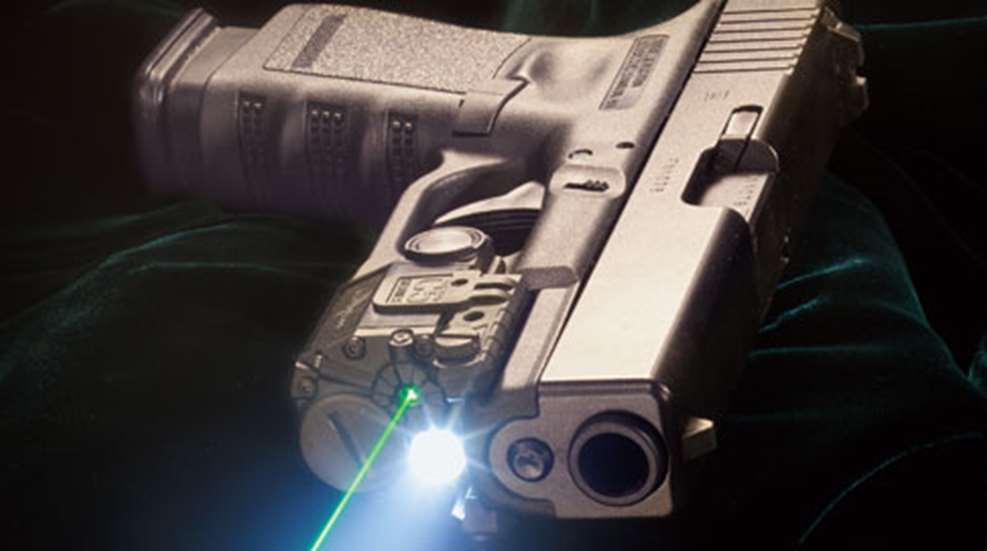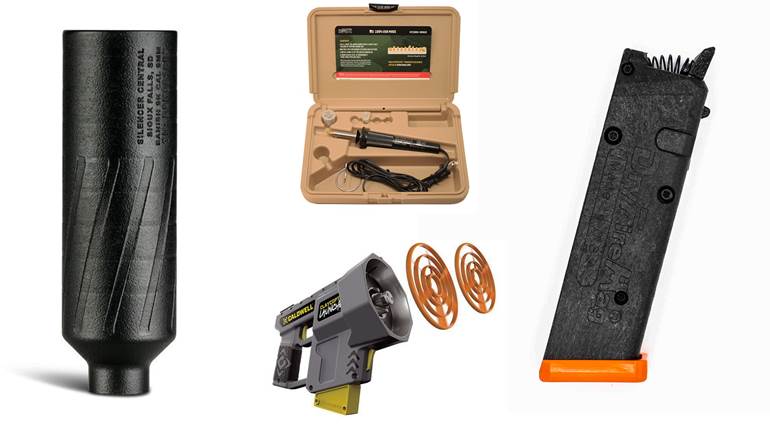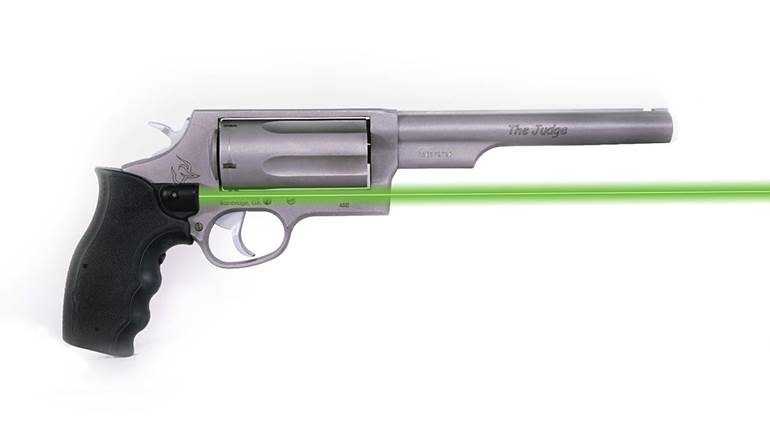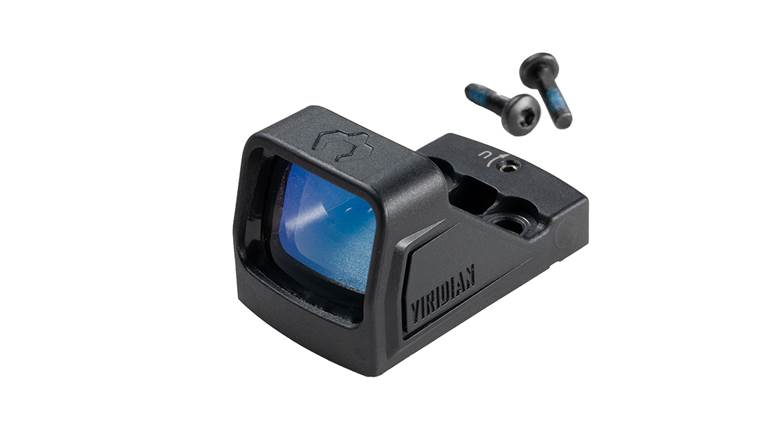
The latest innovations in laser technology, green lasers, are like lightweight .44 Mags.: There’s good news and bad news. The good news is that they are brighter and easier to see than red lasers. The bad news is that green lasers are sensitive to extreme temperatures and are generally more expensive than red lasers.
The use of laser targeting devices on defensive handguns or tactical rifles is a proven method of augmenting traditional sights, either optical or iron. Lasers offer a number of advantages over traditional sights. A laser-equipped firearm can be aimed from awkward positions, such as lying in bed or from behind cover. Second, lasers are easy to see in darkness or in low light, unlike iron sights. Lasers also may serve as a deterrent to potential threats. Prison guards and police officers can recite countless cases of aggressive assailants suddenly becoming born-again pacifists when they see laser dots dancing on their chests. They provide neophyte gun owners who have little or no formal training with an instantaneous means to aim. Aligning iron sights properly takes practice, but pointing a laser is intuitive.
The latest innovation in laser sights for firearms is a beam in the green wavelength of visible light. Before comparing green versus red lasers, let’s start with a basic understanding of laser technology.
If we were sticklers for grammar, laser should be “LASER,” because it’s an acronym for Light Amplification by Stimulated Emission of Radiation, but the term has moved so far into our common lexicon that it’s no longer capitalized. In simpler terms, a laser is a concentrated beam of light.
The concentrated light beam is the result of optical amplification of a specific wavelength of light. Light is electromagnetic radiation—photons energized at specific wavelengths—that is either visible or invisible to the human eye. Invisible light includes high-frequency gamma rays, X-rays and ultraviolet rays, which we feel as sunburn. Our eyes detect a relatively narrow spectrum of light in what is appropriately called the “visible light spectrum.” Lower down the frequency range of light fall infrared, microwaves and radio wavelengths.
Laser beams can be formed by a number of methods, but firearm laser sights—whether green, red or even blue (yes that’s coming), visible or invisible—all utilize semiconductor diodes to create beams.
The U.S. military relies heavily on infrared lasers for night operations. Insight Technology, Laser Devices and other manufacturers specialize in high-intensity, military-grade infrared lasers that, when used in conjunction with night vision goggles, are deadly effective on enemy combatants. Why? Because our troops see infrared lasers through NV optics, and the enemy doesn’t. These “invisible” lasers are used to steer laser-guided bombs and missiles as well as aim M4 combat rifles.
Green Vs. Red Lasers
Lasers are regulated by the U.S. government. The Food & Drug Administration (FDA) restricts the output power of visible lasers that can be sold to “civilians” to no more than 5 milliwatts (mW). The FDA classifies lasers we’re allowed to buy as Class IIIA. They are deemed “eye safe” because if you happen to stare at one, your brain would trigger a blink reflex long before the laser could damage your retina. Because infrared lasers are invisible and thus cannot cause a blink reflex, the FDA highly regulates their sale.
We return now to my reference in the opening paragraph to a green laser’s “brightness.” It is brighter than a red laser even though both are IIIA devices producing 5 mW (or less). The reason is found in the chromatic response of our eyeballs. Our photoreceptors—the rods and cones on our retinas—are more sensitive to light in the green wavelength of 520 to 570 nanometers (nm). We perceive green as being brighter because our photoreceptors are stimulated more easily by this wavelength.
How much brighter? That’s purely subjective. Dr. Peter Hauk, a scientist with SureFire who worked on industrial lasers at the Newport Corp., a world-renowned pioneer in laser products and development, says it’s impossible to state how much brighter a green laser appears. “How old are the eyeballs doing the seeing? Twenty-years-old? Thirty? Forty? Sixty?” Hauk responds. “There’s no way to quantify a subjective impression.”
Laser Devices, a leading manufacturer of green lasers, states that a green laser appears five times brighter than a red laser. Hauk agrees saying that roughly, all things being equal, a green light source is perceived as six times brighter than a comparable red source. However, other manufacturers claim a green laser is everything from 50 to 600 times brighter than a red laser. I think these exaggerated numbers are preposterously high, but there’s no question green is “brighter” than red. Perception is reality, and that’s the good news.
The bad news is that a green laser generates significant heat and is susceptible to thermal shutdown, suddenly blanking out when left on for prolonged periods. Also, green lasers are sensitive to ambient temperature and can malfunction in extremely cold weather.
Why? Because there’s really no such thing as a green laser. The only way to generate a green laser beam is to start with a high-power (100 to 300 mW) infrared laser diode and then through a complicated process, convert the invisible IR beam to visible green. Pay attention to those numbers—you start with 100 to 300 mW of power to produce a mere 5 mW beam. The rest of that energy is not emitted as light, so the law of thermodynamics says it must emerge as heat. And heat is not a friend of diodes. If a diode gets too hot, it shuts down.
Red lasers suffer no such side-effects. A red laser diode produces a red beam; it is as simple as that. There is no conversion of another wavelength, no excess heat, and no danger of frying a red diode.
But the heat is really not an issue in common usage. Are you really going to turn on your laser and leave it on? Laser-sighted firearms are best used with a relatively quick on-off activation method. Tactically speaking, you would not conduct a search with your laser constantly on as it would give away your position to a potential threat. The cold weather sensitivity is equally moot unless you plan on igloo-clearing drills in the arctic circle.
Green Laser Options
SureFire first made a green aiming laser in the mid-1990s; however, the heat issue prevented the company from bringing its green laser to market because it was looking for a military contract, not the commercial market. The technology lay dormant for about 10 years until recently, when manufacturers largely surmounted the thermal issues. This is not to say green lasers are not susceptible to overheating when left activated for long periods, or that they function in extremely cold weather, but these concerns are not deemed prohibitive for today’s commercial market.
Today, all green lasers emit light at the FDA-mandated maximum of 5 mW power. The current manufacturers of green lasers are listed, in alphabetical order, in the accompanying photo gallery along with a brief summary of their models. Of them, only Viridian makes green lasers exclusively. The rest offer mostly red laser products with a few green models. Prices range from less than $100 to more than $3,000 for a government-only version with an accompanying IR laser. You can expect to pay between $200 and $300 for a quality green laser to attach to a handgun or rifle.
In comparing the same laser product in red and green versions, green is more expensive. For example, Crimson Trace upcharges $200 for a green laser version of its MVF-515 vertical foregrip compared to the same product with a red laser. Green lasers cost more to manufacture than red because, as noted, the creation of a green laser relies on converting a high-energy infrared laser source instead of simply installing a red laser diode.
Since FDA-restricted lasers are outside our scope here, that completes our overview of the available green laser sights on the commercial market. So, should you go green? All things being equal, in my opinion, the answer is yes. In the end, the “brighter” perception of green lasers is the kicker. The heat issues are moot, unless you’re in the 10th Mountain and assaulting Mount Everest.





































